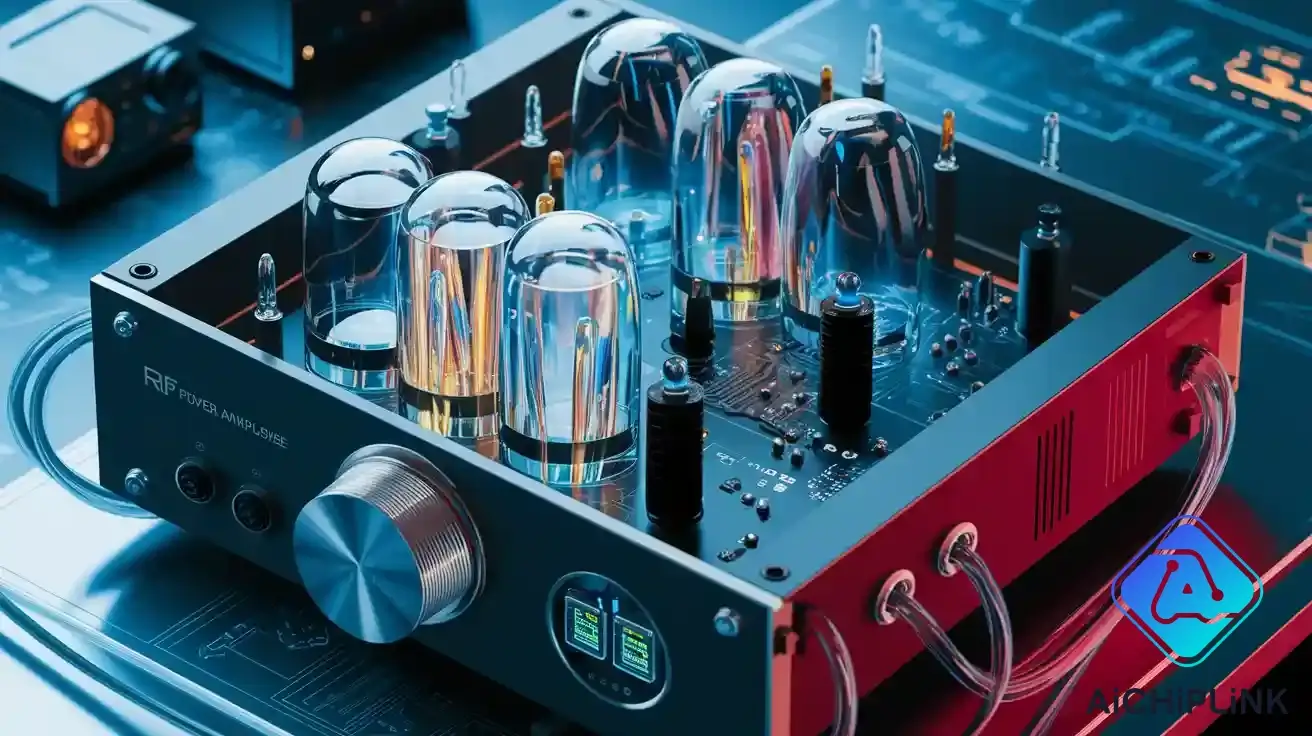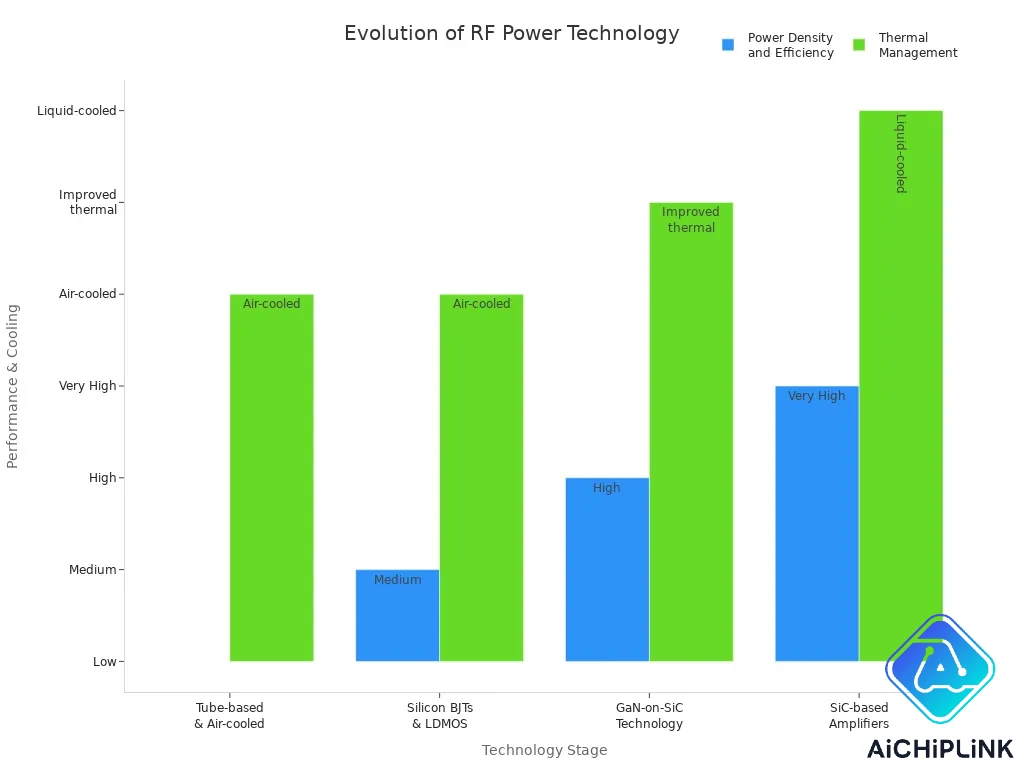
SiC amplifier designs with liquid cooling set new records for RF power in 2025. Silicon carbide parts give more power and work better, changing important systems.
-
In 2025, 39% of new RF amplifiers use liquid or mixed cooling. Linear power ratings over 100W went up by 31%.
-
New ideas include dual-phase cooling, microchannel heat exchangers, and AI-powered checks.
Better cooling helps devices last longer and lets silicon carbide amplifiers keep working well and steady. Groups with high heat problems now have real ways to make RF systems ready for the future.
Key Takeaways
-
SiC amplifiers with liquid cooling give more power. They also handle heat better. This makes RF systems smaller and stronger. It helps them work better too.
-
Liquid cooling keeps amplifiers cool when used a lot. This helps them last longer. It also makes them work well in hard places.
-
Modular design lets people fix things fast. It is easy to make systems bigger or smaller. This means systems can change for different power needs. There is no need to stop working.
-
These amplifiers help important industries like defense and aerospace. They also help satellite communications and 5G. They give steady and strong high-frequency performance.
-
New cooling ways and smart controls save energy. They also lower maintenance costs. This helps the whole system work better.
Impact
RF Power Evolution
RF power technology has changed a lot over time. At first, people used big tube amplifiers with air cooling. These old systems worked okay but were large and not very efficient. They also could not give much power in a small space. Later, silicon BJTs and LDMOS devices became popular. These air-cooled amplifiers were cheaper and lasted longer. But they still had trouble with high power and high frequency.
A big improvement happened with GaN-on-SiC technology. This method mixed gallium nitride with silicon carbide. It helped heat move away faster and gave more power in less space. Engineers could now make smaller and better amplifiers. The newest step uses SiC amplifier designs with liquid cooling. These amplifiers have SiC MESFETs and SITs. They use special cooling and sealed cases. They give more power, last longer, and take up less room.
Cooling methods got better over time. People started with simple heat sinks and air cooling. Now, they use liquid cooling and thermoelectric coolers. These new ways help amplifiers handle more heat and keep working well in hard places.

| Technology Stage | Key Characteristics | Advantages | Limitations | Applications & Notes |
|---|---|---|---|---|
| Tube-based & Air-cooled Systems | Bulky, air-cooled, tube amplifiers | Proven reliability in early radar and comms | Large size, limited efficiency and power | Early radar and communication systems |
| Silicon BJTs and LDMOS (Air-cooled) | Silicon BJTs, LDMOS, air-cooled | Cost-effective, reliable, good linearity | Limited frequency range and power density | Cellular, radar, avionics |
| GaN-on-SiC Technology | GaN on SiC substrates, improved thermal properties | Higher power density, better thermal management | Higher cost, complex thermal management | High power radar, telecom, RRH architectures |
| SiC-based Amplifiers (Liquid-cooled) | SiC MESFETs, SITs, liquid cooling, hermetic pack. | Exceptional thermal conductivity, high reliability, smaller size | Limited frequency range, fewer suppliers | Long pulse radar, avionics, weather radar, long-range tracking radar |
Industry Demands
Today, companies want amplifiers that are stronger and more reliable. They also want them to use less energy. Defense, aerospace, and satellite groups need amplifiers that work at high frequencies. These groups need devices that can handle tough jobs and last a long time. They want amplifiers with high output power and wide bandwidth. Silicon carbide amplifiers are good for this because they handle heat well and give lots of power.
-
Defense and aerospace use SiC amplifier technology for important missions.
-
Satellite communications need amplifiers for Ka and Ku bands. These bands need more power and better cooling.
-
5G and new telecom networks use these amplifiers for wide bandwidth and high gain.
Liquid cooling helps by taking away heat during heavy use. This keeps the amplifiers working well and helps them last longer, even in hard places.
Features
SiC Amplifier Technology
SiC amplifier technology is a big step for RF power systems. Engineers use silicon carbide to make devices that handle more voltage and heat than old designs. GaN-on-SiC amplifiers can now reach up to 800W peak and 100W average output. These amplifiers work better and stay cooler. Digital pre-distortion helps them stay accurate and lowers unwanted signals. New ways to package the parts make each module up to 40% smaller. This makes the systems lighter and easier to move. These changes let us replace large vacuum tube amplifiers in strong RF jobs. SiC power devices also work at higher switching speeds. This is important for 5G and satellite communications.
SiC technology gives more power in less space. It handles heat better and works more efficiently. This sets new records for RF amplifier performance.
-
Some important technical changes are:
-
High output power and better efficiency.
-
Smaller and lighter modules from new packaging.
-
Better accuracy with digital pre-distortion.
-
Faster development using built-in reference designs.
-
Liquid-Cooled Solid-State Power Amplifier
The liquid-cooled solid-state power amplifier is great at handling heat. Liquid cooling uses special fluids to take heat away from amplifier modules. This works better than air cooling, especially when working hard. Thermoelectric coolers soak up heat and move it to a water plate. The water carries the heat to a heat exchanger, which lets it out into the air. This keeps the amplifier at a steady temperature, even when used a lot.
Liquid-cooled modules give more power in less space and work more reliably. The amplifier can work in tough places where air cooling would not work. This technology helps the modules stay efficient and last longer.
-
Benefits of liquid cooling:
-
Gets rid of heat very well.
-
Stays steady at high power.
-
Works better for longer.
-
Integrated 3-Phase SiC MOSFET
The integrated 3-phase SiC MOSFET makes RF power amplifiers more efficient and easier to control. These MOSFET modules can block up to 1200 V and handle up to 550 A. They have low on-resistance, so they waste less energy and work better. The modules can work at temperatures up to 175°C, so they fit tough jobs.
Each module has a built-in gate driver, desaturation detection, and soft-shut-down for safety. These features make the modules safer and more reliable. The 3-phase SiC MOSFET switches quickly, so magnetic parts can be smaller and power density goes up.
Engineers use separation inductance, gate capacitors, and Miller clamp circuits to make the modules safer. These tricks stop current spikes and keep the modules from turning on by accident.
| Specification / Benefit | Details / Description |
|---|---|
| Device Type | Integrated 3-phase SiC MOSFET Intelligent Power Module (IPM) |
| Voltage Rating | Up to 1200 V |
| Current Rating | 340 A to 550 A |
| On-Resistance (RDS(ON)) | 2.53 mΩ to 4.19 mΩ |
| Switching Energy (Eon/Eoff) | As low as 7.48 mJ (Eon) and 7.39 mJ (Eoff) at 600 V / 300 A |
| Operating Temperature | Up to 175°C junction, 125°C ambient for gate driver board |
| Cooling Options | Liquid cooling with pin fin baseplate; air cooling with flat AlSiC baseplate |
| Integrated Features | Gate driver, desaturation detection, Soft-Shut-Down (SSD) |
| Benefits | High breakdown voltage, lower switching losses, high power density, thermal stability |
Liquid-Cooled Modules
Liquid-cooled modules are the main parts of strong, high-power RF systems. Each module is made so engineers can join many together for more power. Designers use radial combiners and dividers to raise power from 2 kW to much higher levels. The modules are easy to replace, so repairs take only 15 minutes.
These modules support systems with no single point of RF failure, making them more reliable. The liquid-cooled solid-state power amplifier system uses these modules to give steady and pulse power for hard jobs.
Modularity and scalability help systems change fast and save money for RF power needs.
| Feature | Description |
|---|---|
| Cooling Architecture | Liquid-cooled scalable solid-state power amplifier system |
| Modularity | Fast field replaceable modules; 15-minute MTTR |
| Scalability | Supports tens to hundreds of kilowatts of CW and pulse power |
| Architecture | Distributed; no single point of RF failure |
| Reliability | High MTBF; robust operation |
| Device Technology | Includes GaN on SiC and LDMOS devices |
| Product Range | Over 500 solutions from basic modules to multifunction assemblies with embedded software |
| Design Approach | Building block combinations for rapid, cost-effective deployment |
-
Main differences:
-
Each module has lots of power in a small space.
-
Liquid cooling helps get rid of heat well.
-
The system is flexible and easy to build.
-
It works reliably and is simple to fix.
-
Benefits
Performance & Efficiency
SiC amplifiers with liquid cooling help RF systems work better. These amplifiers use GaN-on-SiC technology for high gain and good efficiency. The SiC substrate moves heat away fast, so parts stay cool. This helps the devices work well and last longer. Smaller cases are possible because heat leaves quickly.
-
GaN-on-SiC amplifiers use lower voltages, so they avoid many power supply problems that old tube-based systems had.
-
High power density transistors and SiC’s thermal properties keep amplifiers cool, which makes them more efficient.
-
Liquid cooling helps by taking away heat better than air cooling.
SiC amplifiers take the place of old tube amplifiers. They are smaller and lighter but still give high output and efficiency, even when used a lot.
Reliability & Maintenance
Modern SiC amplifiers with liquid cooling are very reliable and easy to fix. The advanced cooling system keeps the temperature steady, so parts last longer.
-
Devices stay cooler by over 100°C compared to old cooling, so they last much longer.
-
Field-replaceable modules let people fix them fast, often in just 15 minutes.
-
Distributed power supplies and hot swapping stop single points of failure, so the system keeps working even if one module needs fixing.
Technicians can count on these amplifiers to work in tough places. This means less downtime and lower maintenance costs.
Scalability & Control
Engineers can make SiC amplifier systems bigger or smaller for any job. Microchannel liquid cooling and modular design make it easy to add more power, from a few kilowatts to hundreds.
-
Companies like Raytheon and Lockheed Martin showed that microfluidic cooling on GaN-on-SiC substrates can more than triple power output and power density while keeping temperatures safe.
-
Wafer-scale manufacturing of microfluidic coolers helps large projects cost less.
-
Integrated control features include built-in firmware, real-time monitoring, and digital phase and gain settings for each amplifier block.
-
Automatic Gain Control, Manual Gain Control, and built-in testing help the system work right.
Using integrated mosfet modules and smart control systems lets operators control performance, reliability, and how big the system can get.
Applications

RF & Communications
SiC amplifiers with liquid cooling are now very important in RF and communications. These systems give strong power and work well for satellite uplinks, radar, and electronic warfare. The Sungrow PowerTitan 3.0 platform shows how a liquid-cooled Silicon Carbide system can give 450kW per unit. It can handle a lot of heat and keep running all the time. In satellite communications, liquid-cooled SiC solid-state power amplifiers take the place of old tube technology. They give at least 4100 w cw and can be swapped out quickly to keep things working.
A 5 kw gan on sic power amplifier gives 5 kw mid-band power. It supports wide bandwidths and high gain. These amplifiers work at high frequencies like Ka and Ku bands. They can give tens to hundreds of kilowatts for hard jobs.
Liquid cooling keeps the amplifiers working steady and clear, even when it is very hot or tough.
| Application Area | Power Output | Key Benefit |
|---|---|---|
| Satellite Uplinks | 4,100 W CW minimum | High reliability, hot swapping |
| Radar & EW | 5 kW mid-band | Wide bandwidth, high gain |
| RF Testing | Up to 24 kW | Modular, scalable, efficient |
Aerospace & Defense
Aerospace and defense need amplifiers that work in hard places. SiC modules are lighter and more reliable because they work at high temperatures. NASA found that SiC electronics can work without extra cooling. This saves weight and helps planes use less fuel. CISSOID’s SiC modules have liquid-cooled pin fin baseplates. This gives high power and keeps things steady.
These modules can handle high voltage and power. They are good for missions like going to the moon and new aircraft. SiC amplifiers with liquid cooling help control heat and keep working well in very tough places.
-
Lighter modules help save fuel and lower pollution.
-
Working steady at high temperatures makes them more reliable.
-
High switching speeds let systems be smaller and stronger.
| Requirement Aspect | How SiC with Liquid Cooling Helps |
|---|---|
| High Voltage | Easier scaling, fewer modules |
| High Power | Compact, efficient converters |
| SWaP | Smaller, lighter, less cooling hardware |
| Thermal Management | Stable in harsh, high-temp environments |
Automotive & Industry
Cars and factories now use SiC amplifiers with liquid cooling to handle lots of heat and power. In electric vehicles, these modules cool batteries and brakes. This keeps everything safe and working well. Jet impingement cooling can drop SiC module temperatures from 290°C to 169°C at a 151 W heat load.
Industrial power electronics, like motor drives and renewable energy, use forced cooling with thermoelectric modules. These cooling ways make heat sinks work up to 200% better. They lower junction temperatures and help things last longer.
New liquid cooling and modular design help SiC amplifiers meet the bigger needs of cars and factories.
SiC amplifiers with liquid cooling give lots of power and work well. They are very reliable for RF systems. These amplifiers help radar, 5G, and aerospace by working in tough places. They also help lower the chance of breaking down. New microfluidic cooling, like in DARPA’s ICECool program, makes them work even better.
-
Companies such as John Deere see big improvements in how well things work. They also have less pollution with these systems.
-
Materials from Coherent Corp. help engineers control heat in new designs.
These new ideas make it possible to build smaller and stronger RF amplifiers. Readers can learn about these new solutions and keep up as technology changes.
FAQ
What makes SiC amplifiers with liquid cooling better than air-cooled models?
SiC amplifiers with liquid cooling get rid of heat faster. They can work at higher power without getting too hot. They last longer in hard places like factories or planes. Engineers pick them because they are strong and save energy.
Can technicians replace liquid-cooled modules in the field?
Technicians can change out modules very fast. Most fixes take under 15 minutes to finish. The design lets people swap parts quickly. This means less waiting and systems keep working.
Are SiC amplifiers with liquid cooling safe for mission-critical applications?
These amplifiers have safety features built in. They use special gate drivers and sensors to watch for heat. They follow strict rules for planes, defense, and communication jobs.
How does liquid cooling affect amplifier size and weight?
Liquid cooling lets the cases be smaller. The system takes up less room. Lighter modules help in cars and planes. Designers make small systems for many kinds of work.
What maintenance do liquid-cooled SiC amplifiers need?
Regular checks keep the cooling fluid clean. Technicians look at the connections and sensors. Most systems warn users if something is wrong. Maintenance is quick and easy.

Written by Jack Elliott from AIChipLink.
AIChipLink, one of the fastest-growing global independent electronic components distributors in the world, offers millions of products from thousands of manufacturers, and many of our in-stock parts is available to ship same day.
We mainly source and distribute integrated circuit (IC) products of brands such as Broadcom, Microchip, Texas Instruments, Infineon, NXP, Analog Devices, Qualcomm, Intel, etc., which are widely used in communication & network, telecom, industrial control, new energy and automotive electronics.
Empowered by AI, Linked to the Future. Get started on AIChipLink.com and submit your RFQ online today!




